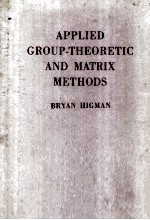图书介绍
Applied Group-Theoretic and Matrix MethodsPDF|Epub|txt|kindle电子书版本网盘下载

- Bryan Higman 著
- 出版社: At The Clarendon Press
- ISBN:
- 出版时间:1955
- 标注页数:454页
- 文件大小:135MB
- 文件页数:468页
- 主题词:
PDF下载
下载说明
Applied Group-Theoretic and Matrix MethodsPDF格式电子书版下载
下载的文件为RAR压缩包。需要使用解压软件进行解压得到PDF格式图书。建议使用BT下载工具Free Download Manager进行下载,简称FDM(免费,没有广告,支持多平台)。本站资源全部打包为BT种子。所以需要使用专业的BT下载软件进行下载。如BitComet qBittorrent uTorrent等BT下载工具。迅雷目前由于本站不是热门资源。不推荐使用!后期资源热门了。安装了迅雷也可以迅雷进行下载!
(文件页数 要大于 标注页数,上中下等多册电子书除外)
注意:本站所有压缩包均有解压码: 点击下载压缩包解压工具
图书目录
PART Ⅰ FINITE GROUPS1
Ⅰ.ABSTRACT FINITE GROUPS1
1.2.The cyclic group of order2
1.3.The dihedral groups3
1.4.S-groups5
1.5.Permutation groups5
1.6.Basic definitions and theorems7
Ⅱ.MATRIX ALGEBRA10
2.2.Linear operators10
2.3.Combinations of operators12
2.4.Matrix algebra and group theory13
2.5.Non-square matrices14
2.6.The theory of vector spaces14
2.7.Eigenvectors and eigenvalues16
2.8.Functions of a diagonal operator18
Ⅲ.COMPLEX AND HYPERCOMPLEX NUMBERS20
3.2.Scalar products and vector duals20
3.3.Related matrices:(i)the adjoint and reciprocal22
3.4.Related matrices:(ii)the transpose and associate23
3.5.Related matrices:(iii)orthogonal and unitary matrices23
3.6.Eigenvalues of special matrices24
3.7.Reciprocal vectors25
3.8.Dyads and dyadics26
3.9.Linear algebras30
3.10.Nomenclature32
Ⅳ.CONJUGATION AND EQUIVALENCE33
4.2.Conjugation34
4.3.Factor groups34
4.4.The implications of equivalence36
4.5.The algebra of classes37
4.6.Oblique axis theory37
4.7.Reduction of a matrix to diagonal form41
4.8.Functions of an arbitrary operator42
Ⅴ.REPRESENTATIONS--THE HEART OF THE MATTER45
5.2.Reducibility45
5.3.The fundamental theorems48
5.4.Some simple corollaries50
5.5.Group characters51
5.6.Induced and Kronecker product representations54
Ⅵ.REVIEW OP GROUPS TO ORDER 2458
6.2.Cyclic groups58
6.3.S-groups58
6.4.Groups up to order 660
6.5.Groups of orders 7 and 862
6.6.Direct product and generalized dihedral groups64
6.7.Groups of orders 9 to 24;symmetric groups66
Ⅶ.MISCELLANEOUS ADDENDA AND NUMERICAL METHODS72
7.2.Matrices not reducible to diagonal form72
7.3.Numerical evaluation of determinants74
7.4.The reciprocal of a matrix76
7.5.Computation of eigenvalues and eigenvectors78
7.6.The orthogonality relations83
7.7.Operator space86
7.8.Some miscellaneous proofs89
PART Ⅱ APPLICATIONS OF FINITE GROUPS90
Ⅷ.THE EXTERNAL FORMS OF CRYSTALS90
8.2.Forms without multiple axes93
8.3.Forms with one multiple axis95
8.4.Forms with more than one multiple axis96
8.5.Graphical representation of symmetry types99
Ⅸ.THE INTERNAL STRUCTURE OF CRYSTALS102
9.2.The lattice hypothesis104
9.3.The three-dimensional point lattices:(i)from lattice to symmetry108
9.4.The complete lattice group110
9.5.The three-dimensional point lattices:(ii)from symmetry to lattice118
9.6.The conventional axes and matrices122
9.7.The space groups125
9.8.The reciprocal lattice133
Ⅹ.THE VIBRATIONS OF MOLECULES136
10.2.Procedure for transformation of coordinates137
10.3.The normal modes of symmetrical molecules139
10.4.The structure of the ozone molecule(i)140
10.5.Numerical determination of natural frequencies147
Ⅺ.FACTOR ANALYSIS149
11.2.The basic problem of factor analysis149
11.3.A simple solution151
11.4.Correlation and rank152
11.5.Correlation and error154
11.6.Transformations of the f-space157
11.7.Rotation of axes and oblique factors161
11.8.Application to the problem of aromatic activity163
11.9.Spearman's approach170
PAST Ⅲ CONTINUOUS GROUPS AND APPLICATIONS174
Ⅻ.CONTINUOUS GROUPS:INTRODUCTION174
12.2.Representations and characters in continuous groups174
12.3.The groups u2 and r3177
12.4.Representations of u2 and r3182
12.5.The numerical groups185
12.6.Infinitesimal operators and the group manifold187
12.7.Differential operators and Hilbert space189
12.8.Eigenvector theory in Hilbert space196
12.9.Functions of two or more variables202
ⅩⅢ.THE SYMMETRIC AND FULL LINEAR GROUPS205
13.2.The simple symmetric functions205
13.3.Relations between the symmetric functions207
13.4.The Kronecker mth power209
13.5.The simple characters of fn212
13.6.The characters of the symmetric groups215
13.7.Schur functions219
13.8.Further development of Schur functions222
13.9.Subgroups of the symmetric and full linear groups226
13.10.The spinor group231
ⅩⅣ.TENSORS237
14.2.The metric tensor237
14.3.General notions239
14.4.The volume element and the Laplace operator244
14.5.Tensor properties of matter:(i)symmetrical tensors249
14.6.Tensor properties of matter:(ii)in crystals255
14.7.The identification of tensor types259
ⅩⅤ.RELATIVITY THEORY266
15.2.The Galilean transformation267
15.3.The Lorentz group268
15.4.The representations of the Lorentz group270
15.5.The four-dimensional principle273
15.6.Curvature of space277
15.7.The basic principles of general relativity283
15.8.Relativistic and quantum-relativistic units284
ⅩⅥ.QUANTUM THEORY288
16.2.The basic postulates289
16.3.Vector observables292
16.4.The commutation rules and wave functions296
16.5.The Schrodinger equations301
16.6.The free particle and the simple harmonic oscillator306
16.7.Central force fields and spherical harmonics308
16.8.Perturbation theory315
16.9.Symmetry considerations320
16.10.n-Electron systems335
ⅩⅦ.MOLECULAR STRUCTURE AND SPECTRA344
17.2.Diatomic molecules345
17.3.Methods of molecular analysis352
17.4.Tetrahedral molecules358
17.5.Covalency maxima and stereochemistry366
17.6.Unsaturated compounds374
17.7.Spectra and selection rules385
17.8.The structure of ozone(ii)393
17.9.Related problems in crystals399
ⅩⅧ.EDDINGTON'S QUANTUM RELATIVITY402
18.2.The nature of measurement403
18.3.Measures and measurables404
18.4.The E-frame and sedenion algebra406
18.5.Rotations and reality conditions409
18.6.Anchoring the E-frame411
18.7.The primary analysis417
18.8.k-Factor theory419
18.9.Strain vectors and quantum theory425
18.10.The double frame and wave tensors430
18.11.The cosmic number440
18.12.Conclusions441
BIBLIOGRAPHY444
INDEX449